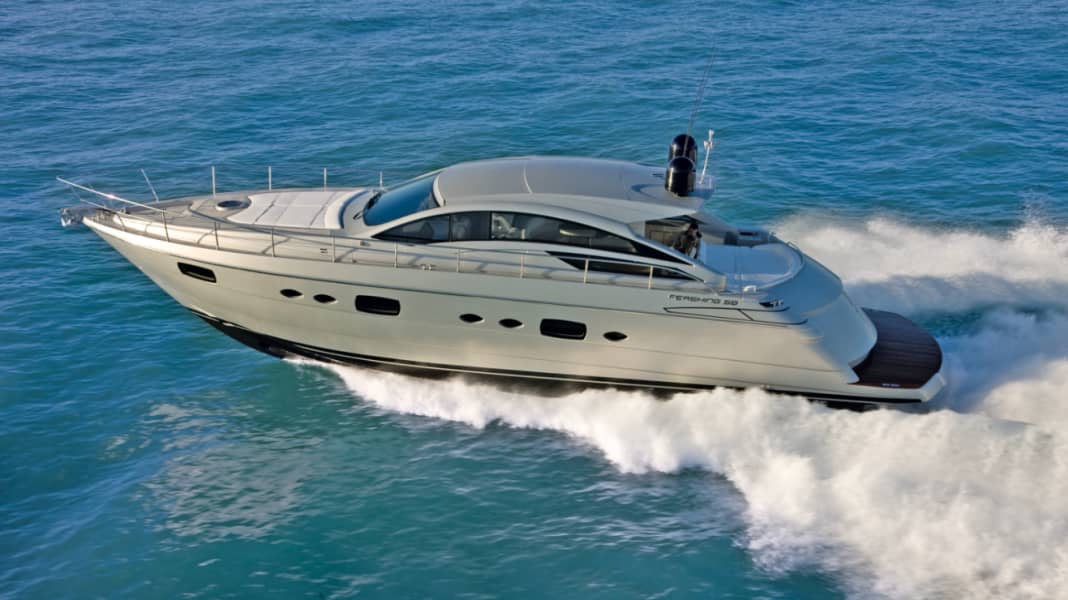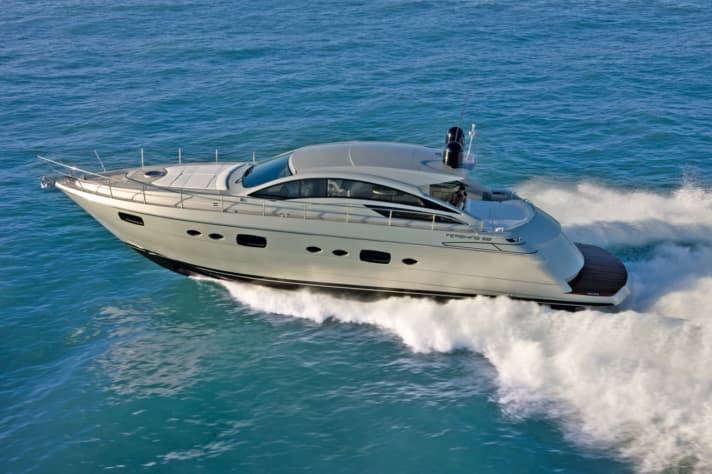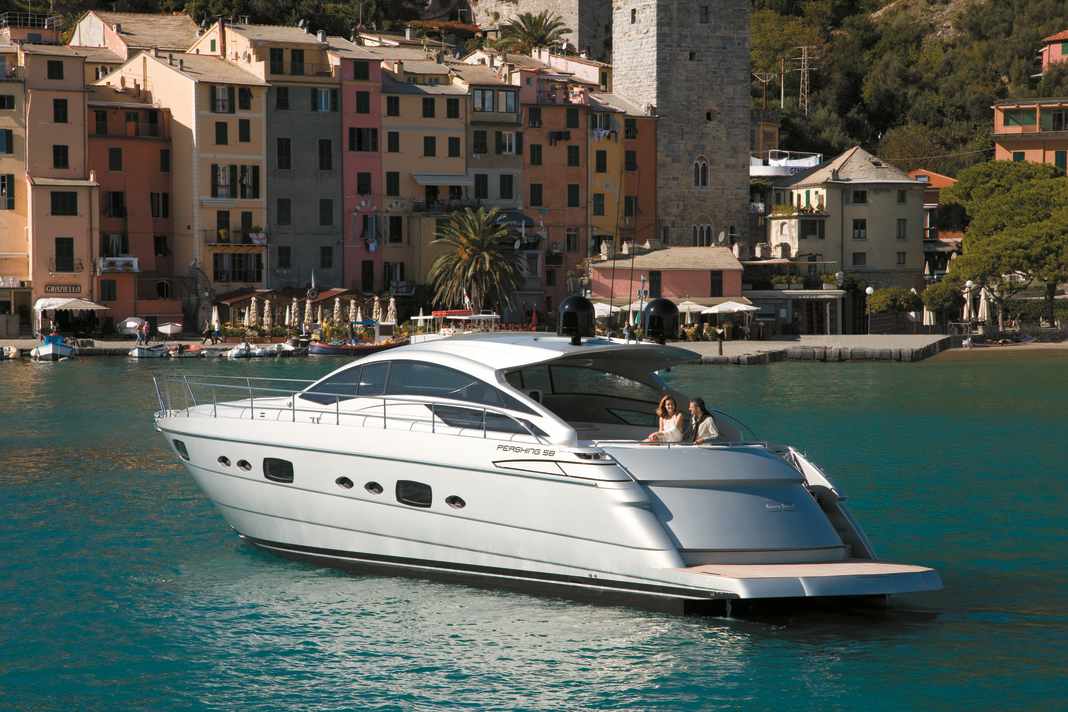







Anyone who has ever seen a Pershing pass by or even travelled on one themselves will immediately feel the joy that these "driving machines" give you. Two 1360 hp MAN diesels are responsible for this in our test boat, the Pershing 58, which transfer their power to the water via Arneson drives.
Drives equipped with special surface propellers on shafts that can be steered and trimmed like Z-drives. The advantage of this technology is that the faster you glide, the higher the drives are set and the propellers are only partially submerged, which results in high efficiency and therefore plenty of speed.
Disadvantage: In the lower speed range, the propellers ventilate before they become fully friction-locked. But this feature also conveys a sporty character, because when the propellers gain grip after snapping the air, the hull, which weighs just under 29 tonnes, accelerates upwards without a hitch. The bow lifts only slightly and visibility always remains good. The trim tabs are helpful in this situation; when gliding, the tabs are raised further and further and the drives are raised slightly. A sure instinct is required to find this optimum boat position. If everything is right, the Pershing pulls a huge tail behind her and reaches a respectable 50 knots.
It should be clear to everyone that two diesel engines over 1000 hp are not exactly squeamish with fuel. Expressed in figures: just under 11 l/sm. With a diesel supply of 3200 litres minus 15% reserve, this gives a range of 252 nm. The shipyard recommends a cruising speed of 1800 rpm with a speed of just under 35 knots. Our test analysis also shows that we are right on this point, with the lowest consumption at 1800 rpm at planing speed. That is still a good 8 l/sm, which in turn means a range of 331 nm - not exhilarating for a CE category A boat.
Fast cornering: The only negative point to note here is that visibility to the inside of the bend is zero on port bends, as the Pershing lies so far to one side that all you can see is water. During fast cornering manoeuvres, there is no rocking or hooking apart from the soft rocking into your own wave. On slalom courses, the boat swings safely from one side to the other, and the hull settles softly when the steering is turned.
The steering was only sufficiently smooth during all manoeuvres. Going slowly with a Pershing is contrary to its character, but even these boats have to enter the harbour or bay from time to time, where crawling is the order of the day. To prevent the speed from becoming too fast, especially in the harbour, the shipyard installs a trolling device that reduces the displacement speed to around 3 knots at a good 6 knots at idle speed (600 rpm). You hardly have to steer at all, because with engines of the same speed, the Pershing runs straight ahead, almost as if pulled by a string. Mooring or manoeuvring into the box is done precisely and safely with the gears engaged in opposite directions and with the bow and stern thruster installed on our test boat.
The shipyard has designed the skipper's command centre with contemporary high-tech. This includes the obligatory Pershing steering wheel with just one spoke, electronic gearshift box from ZF, easy-to-read instruments and a gearshift unit like in the cockpit of an aeroplane. The sports seat in front can only be adjusted in the reclined position; otherwise it offers no adjustment options - which is reflected in the moderate legroom between the low steering wheel and seat. The standing driver has a better time if he folds up the front seat and stands in front of it.
The view through the huge, slightly tinted windscreen is hardly disturbed by reflections, as the driving position is exemplary dark. Two large windscreen wipers ensure an unclouded view when driving in the rain. Fresh air is supplied through the side windows, which can be opened and closed at the touch of a button. The same applies to the huge sunroof above the driver and front passenger seats.
The cockpit seating area with wet bar is located aft. The stern is dominated by a huge sunbed, under which you will find the tender garage. Of course, this is not just any "boat", but a Williams tender with jet propulsion. It gets in and out of the water with the help of a remote-controlled gangway. Bathing enthusiasts climb out of the water via a ladder (electrically powered). The shower (hot/cold) on the huge bathing platform is ideal for rinsing off.
The first glance into the saloon area with its cosy seating area and galley block shows that the Pershing 58 also offers something special below deck. Here, as in all cabins and bathrooms, light and dark contrasts are accentuated by elegantly designed furniture. The lower deck layout is available in two variations: The cosy owner's cabin in the middle section (across the entire width with a wet room) and the VIP cabin in the foredeck remain the same.
the VIP cabin in the foredeck (also with its own bathroom) always remain identical.
The difference lies in between: There is either a cabin with two single beds for children or a walk-in wardrobe, as on our test boat. The associated wet room, which also serves as a day toilet, can be accessed from the vestibule. There is also a crew cabin in the aft section.
Access to the engines is via a hatch and ladder on the sun lounger. The mechanic has plenty of headroom in the entrance area, but has to bend down a little further forwards. There is plenty of space around the engines, which makes servicing easier. Apart from a cable duct that was too small (the cover bulged and had to be held in place with cable ties), the installations are neat and tidy. Plus points are also awarded for the securely crimped diesel lines, large fuel filter with sight glass and electric alarm, shut-off valve, fire extinguishing system, powerful bilge pump and self-extinguishing sound insulation.
To ensure safe movement on deck, non-slip floor structures are just as much a standard feature as the sturdy railing with beam. The Pershing can be moored to solid cleats that are screwed through reinforced laminate. The shipyard provides the latter with a gelcoat and 2-component paint on the outside and a clean protective coating on the inside, which can also be found on the deburred cut edges.
Conclusion: It's fun to thunder across the water with the Pershing 58. The sporty handling characteristics are complemented by all the equipment and the attractive styling. There are only a few points of criticism regarding the workmanship and installations.
Data sheet: Pershing 58
Shipyard: Ferretti S.p.A.
Type designation: Pershing 58
CE category: A - High seas
Length: 18,00 m
Width: 4,80 m
Displacement: 0,03 t
Price: 2.058.700,00 €

